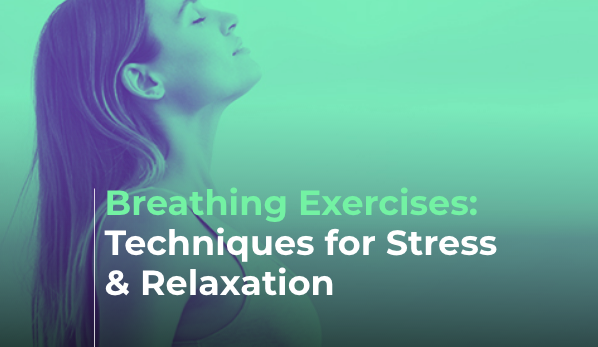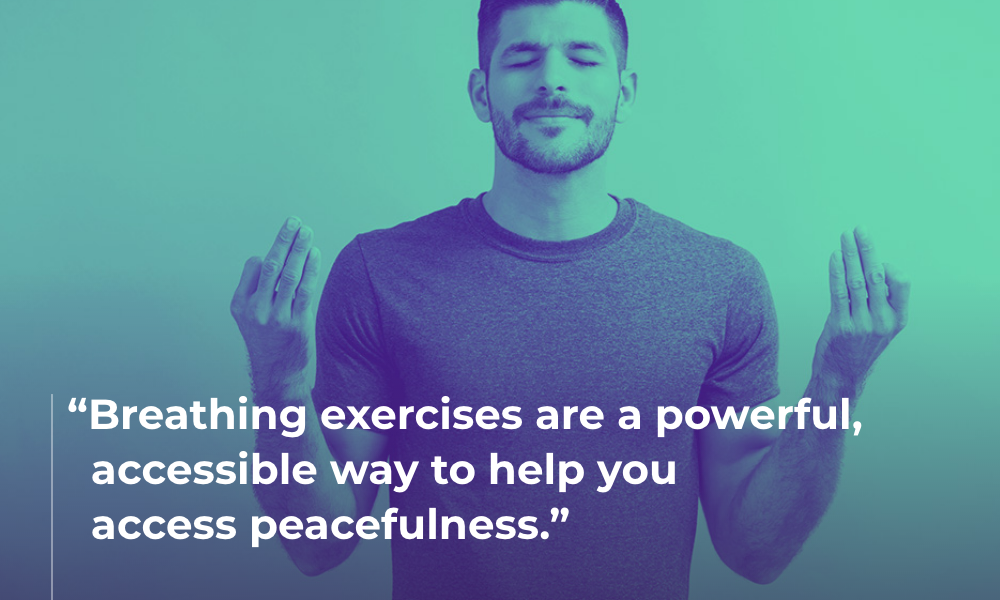Breathing exercises are excellent tools to reduce stress and help you feel relaxed. They’re highly effective for helping you calm down after a stressful day or for giving you the energy you need to get through the last hour of work.
In this article, we explore the benefits of practicing breathing exercises and how to do them correctly. We also share the best exercises you can do for relaxation, energy, and more. Take a slow relaxing breath, then let’s get started!
Breathing Exercise Benefits
Breathwork is an incredible tool to have, because it has multiple uses. Depending on the technique you use, you can use your breath to calm down and relax, or you can use it to feel more motivated and energetic. There are also breathing techniques that act as “equalizers”– so if you’re feeling down, they’ll bring you up. And if you’re feeling too up (think hyper or anxious), they’ll bring you down to a calmer place.
Breathing exercises can also have other benefits. They can stimulate your lymphatic system, which maintains bodily fluid levels, removes waste, and helps prevent sickness. These exercises can also help improve your digestion, lower your blood pressure and even reduce pain.
That said, always speak with a medical professional before starting a new breathing exercise practice. This is especially true if you have asthma or another lung condition. If you have symptoms like dizziness or faintness after your first couple of times practicing a new breathing technique, stop doing it. Then, consult with your doctor.
Once your medical professional gives you the okay, it’s time to get started. But to reap the benefits of breathing exercises, you’ll need to do them correctly, and that means learning how to breathe from your diaphragm.
Abdominal Breathing vs Chest Breathing
Breathing from your diaphragm—referred to as diaphragmatic breathing, abdominal breathing, or belly breathing—is an essential skill for doing breathing exercises. In fact, abdominal breathing can be an entire breathing exercise in and of itself.
To understand how abdominal breathing works, start by observing how you’re breathing right now. Are you taking full breaths all the way into your abdomen, so your stomach expands with each inhale? Or, are you taking breaths into your chest so that your stomach barely moves?
If you’re like most adults, it’s probably the latter. And that’s okay! Though most of us are born as belly breathers, we tend to shift to shorter chest breaths as we mature into adulthood. There’s no need to beat yourself up about it.
But, now that you realize it, you may want to consider shifting back to breathing into your belly.
You likely know that your body needs to inhale oxygen and release carbon dioxide to function properly. With shallow breathing, your body doesn’t exchange the right amount of gases. But abdominal breathing allows you to inhale and release the full amount of oxygen and carbon dioxide that your body needs. When this happens, your body can calm down. You’ll notice that your heartbeat slows and you instantly feel more relaxed.
If you’d like to try abdominal breathing, we recommend starting by lying down. Belly breathing is easier to do when you stretch out on your back. Begin by incorporating a few belly breaths into your morning routine and build up to more over time. If you try to shift over to full-time belly breathing all at once, you may experience dizziness and other unpleasant sensations. So take it slow!
A final word to the wise: Make sure your belly is inflating with each breath because you’re breathing into it. Be sure it’s not rising because you’re subconsciously using your muscles to puff it out. This is an easy mistake to make.
A final word to the wise: Make sure your stomach is inflating because you’re breathing into it, and not because you’re subconsciously using your muscles to puff it out. This is an easy mistake that beginners make.
Getting Started with Breathing Exercises
The good news about breathing exercises is that they don’t require any equipment or skills to get started. You can feel better with these impactful exercises anytime, anywhere.
Here are some guidelines to keep in mind as you start your breathwork:
- Unless otherwise specified, it’s preferable to breathe in and out through your nose (rather than through your mouth).
- If you do exhale through your mouth for an exercise, it’s generally best to do it with pursed lips. This controls the amount and speed of your exhale, which reduces the chances of creating dizziness or anxious feelings.
- You can practice breathing exercises whenever you want and as often as you want. It’s especially beneficial to do calming breathing exercises before you go to sleep at night. However, some breathing exercises may feel intense or dizzying at first. We suggest doing these less frequently at first, then building up over time (the way you would with physical exercise).
- You may find it easier to take full belly breaths (which most exercises require) while lying down.
- Although most breathing exercises are simple, that doesn’t mean they’re always easy. Adjusting to a new way of breathing can be challenging, so have grace with yourself as you learn new exercises.
- Especially at first, it’s best to practice your breathing exercises in private. That way, you can focus on your technique without distraction or fear of judgment.
- Don’t let a lack of time prevent you from doing breathing exercises. If you only have one spare minute to lie down and practice belly breathing, then that’s one minute well spent!
Breathing Exercise Options
Just like there are many types of yoga, there are many types of breathing exercises. But don’t get overwhelmed!
Just like any type of yoga will benefit your health, so too will any type of breathing exercise. You can’t really choose a wrong one from this list.
We encourage you to take your time experimenting with different exercises to see what feels best in your body.
There’s no rush and no finish line that you need to reach. Also, keep in mind that different breathing exercises will serve you best in different situations. So once you have a few techniques in your arsenal, you can pull out whichever works best for the moment.
Alternate-Nostril Breathing
Alternate-nostril breathing (also known as “Nadi Shodhana”) is one of the more fun techniques on this list (in our opinion)! It requires some coordination of fingers and breath, so it’s also an excellent way to focus on something other than the source of your stress.
Alternate nostril breathing lowers your stress levels, slows your heart rate, and helps you relax.
Here’s how to practice alternate nostril breathing:
- Sit in a comfortable position. Rest your left hand on your lap.
- Using your right hand, place your thumb on your right nostril and your pinky finger on your left nostril. Place your pointer, middle, and ring fingers on your forehead.
- Exhale all of the air from your lungs.
- Close your right nostril with your thumb.
- Breathe in through your left nostril.
- At the top of the inhale, close your left nostril with your pinky finger.
- Release your thumb and breathe out through your right nostril.
- Breathe in through your right nostril.
- At the top of the inhale, close your right nostril with your thumb.
- Release your pinky finger and breathe out through your left nostril.
- Repeat for as many breath cycles as you need, starting with step 5.
If you’re experiencing some congestion, wait until you feel better to practice alternate nostril breathing. It can be tricky to do with a stuffy nose. Also, to avoid infection, it’s always a good idea to wash your hands before touching them to your face for alternate nostril breathing.
Box Breathing
Box breathing is one of the most easy-to-remember deep breathing techniques because you only have to keep track of one thing: the number 4! Here’s how to practice box breathing:
- Start by exhaling all of the breath currently in your lungs.
- Inhale through your nose for a count of 4.
- Hold for a count of 4.
- Exhale through pursed lips for a count of 4.
- Pause for a count of 4.
- Repeat for as many breath cycles as needed to relax.
Box breathing relaxes your nervous system, allowing you to let go of stress. When you initiate that 4-second pause after inhaling and exhaling, you allow carbon dioxide to build up in your system.
Though this may sound scary, it’s actually a good thing because it stimulates your parasympathetic nervous system, allowing you to relax. Start with a 4-4-4-4 box breath, and if you’d like, you can work your way up larger numbers. Just be sure to inhale, hold, exhale, and hold for the same amount of time.
4-7-8 Breathing
Much like box breathing, the 4-7-8 breathing technique uses pauses in your breath to build carbon dioxide in your system and help you relax. This specific ratio is excellent for evoking tranquility in your body, so be sure to stick with this count:
The 4-7-8 technique directs you to inhale for 4 seconds, hold your breath for 7 seconds, and then exhale for 8 seconds. To do it:
- Breathe out to rid your body of air.
- Breathe in through your nose for 4 seconds.
- Hold your breath for 7 seconds.
- Exhale through pursed lips for 8 seconds.
- Repeat for as many breath cycles as you need to feel calm.
It’s normal to experience some dizziness or light-headedness when you first try this technique (or any other technique on this list). Not only will that go away with time, but the technique will actually become more powerful and effective with each use. That said, use caution and stay seated when you’re first practicing, just in case.
Lion’s Breath
Stress can make your body feel tight and tense. And the feeling of tension in your body can generate more mental unease. It’s a vicious cycle that you need to find your way out of. Enter: lion’s breath. This aptly-named breathing technique helps you release (or should we say roar) out some of that tension and pent-up emotions, so you can return to a relaxed state. Here’s how to do it:
- Sit comfortably.
- Lean forward and place your hands on your knees.
- Breathe in through your nose.
- Open your mouth, stick out your tongue and stretch it downward.
- Exhale emphatically while making a “ha” sound.
- After you’ve finished, breathe normally.
- Repeat for as many breath cycles as you need to release tension.
Although you can do any breathing exercise in the presence of other people, this one is hard to do subtly. That’s why we recommend doing it in private. That way, you can really let loose with your “ha” sounds and get the most from this exercise.
Mindful Breathing
Mindful breathing is the practice of drawing all your attention to your breath, just as you do in meditation. Mindful breathing can lead to fewer negative emotions like stress, and it can help you regulate your emotions. To practice mindful breathing:
- Sit comfortably in a quiet place.
- Begin by exhaling all of the air out of your lungs.
- Take a couple of slow, relaxing breaths.
- As you inhale, direct all your attention to the air entering your lungs
- As you exhale, direct all your attention to the breath leaving your body.
- When your mind wanders away from your breath, simply notice it. Then return to the breath.
- Repeat for as many breath cycles as needed to relax.
As a bonus, you’re also successfully performing mindfulness meditation when you do this exercise. Try doing it every morning before you start your day, and you’ll likely see reduced stress over time.
Pursed-Lip Breathing
Have you ever taken a deep breath in, followed by a large exhale, and found that you felt a little dizzy? When we release air from our bodies too quickly, it can result in anxious or uneasy feelings. In order to exhale in a way that promotes calm and reduces stress, we need to control how quickly we expel air from our bodies.
The best way to do this? Pursed-lip breathing. Before you exhale from your mouth, try pursing your lips (like you’re going to whistle). When you do this, you restrict the amount of air coming out of your body at once. This regulated exhale speed can help to keep everything in balance and promote a sense of relaxation and calm.
To do it:
- Breathe in for 2 seconds.
- Purse your lips as if you’re going to whistle.
- Breathe out for 4 seconds, making a whoosh sound.
- Repeat for as many breath cycles as needed to relax.
You can do pursed-lip breathing anytime you need to de-stress during your day. We even recommend using this one consistently throughout the day to maintain a feeling of calm and relaxation.
Resonance Breathing
Another way to reduce stress is to relax your nervous system through resonance breathing. This technique asks you to slow your breath down to 6 breaths per minute, which reduces your heart rate and helps you relax. Here’s how to practice resonance breathing:
- Breathe in through your nose for 4 seconds.
- Breathe out through pursed lips for 6 seconds.
- Direct your thoughts to your breath. When they wander, simply return them to your breath.
- Repeat for as many breath cycles as you need to feel calm.
Breathing in this way will naturally lead your body to take about 6 breaths every minute. This can be a difficult breathing technique to do correctly at first, so try not to get frustrated if you mess up. You’re taking steps to benefit your physical and mental health, and that’s the important part!
Equal Breathing
Equal breathing requires you to breathe in for the same amount of time that you breathe out. You can think of this technique as box breathing without holding your breath. Just like box breathing, start out for a count of 4, but feel free to work up to higher counts.
To do equal breathing:
- Begin by sitting or lying down.
- Expel all of the air from your lungs.
- Then, inhale for a count of 4.
- Finally, exhale for a count of 4.
- Repeat for as many breath cycles as needed to relax.
Like some of the other techniques on this list, equal breathing helps you slow down your breath. In turn, this slows down your heart rate and reduces feelings of stress. Because they are so similar, you might try practicing both equal breathing and box breathing to see which one you prefer.
Combining Breathing Exercises with Mindfulness Meditation
Breathing exercises are a powerful, accessible way to help you access peacefulness. They help reduce stress levels, lower blood pressure, and after you use them, you can carry on with your day in a more relaxed state.
They’re excellent tools to have in your mindfulness arsenal. And they work best when combined with mindfulness meditation.
While many people use breathing exercises to cope with the stress that they are already experiencing, mindfulness meditation is an excellent way to prevent that stress from happening in the first place.
A regular mindfulness meditation practice is proven to reduce the amount of stress you feel over time. Importantly, meditation also reduces the negative, inflammatory effect of stress on your body which can exacerbate pre-existing health conditions like arthritis, asthma, chronic obstructive pulmonary disease (COPD), heart disease, and even cancer.
So if you’d like to be as stress-proof as possible, we recommend picking up a meditation routine along with your favorite breathwork practice from this list. A guided meditation app like Primed Mind is one of the easiest ways to get started with meditation.
Created by one of the world’s leading mindset coaches, Primed Mind features guided meditation “primers.” Each primer is from 5 to 20 minutes in length and is designed to help you gain peace and reach your goals. Those interested in pairing their meditations with breathwork will like our power primer “Breathe and Energize” and our deep primer on energizing yourself.
Primed Mind is free to download, so get started breathing your way to less stress today!



